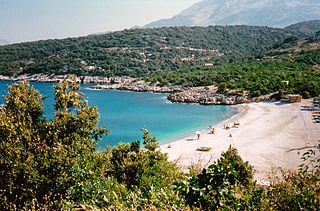
Piperi is a historical tribe (pleme) of Albanian origin and a region in northeastern Montenegro. Piperi is located between the Morača and Zeta rivers up to the northern suburbs of the Montenegrin capital Podgorica.

Kuči is a historical tribe (pleme) of Albanian origin and a region in central and eastern Montenegro, north-east of Podgorica, extending along the border with Albania. Processes of Slavicisation during the Ottoman era and onwards facilitated ethno-linguistic shifts within much of the community. As such, people from the Kuči today largely identify themselves as Montenegrins and Serbs, with a minority still identifying as Albanians. In other areas such as the Sandžak, many Muslim descendants of the Kuči today identify as Bosniaks.

Mrkojevići is a historical tribal region in southwestern Montenegro, located between the towns of Bar and Ulcinj. The region borders Krajina to the east. The Mrkojevići form a distinct ethno-geographical group with their own dialect of the Serbo-Croatian language, while also exhibiting a degree of bilingualism in Albanian. Their customs are distinct from their neighbouring Slavic and Albanian communities, but they also show influence and contacts with them. In the 400-year Ottoman period, the Mrkojevići converted to Islam, which forms an important aspect of their cultural identity.

Hoti is a historical Albanian tribe (fis) and sub-region of Malësia, a divided area located in northern Albania and southern Montenegro. Its geography is mostly mountainous, but some of its villages are on flat terrain near the banks of Lake of Shkodër.

Bjelopavlići is a historical tribe (pleme) of Albanian origin and a valley in the region of the Brda, in Montenegro, around the city of Danilovgrad.

Shkreli is a historical Albanian tribe and region in the Malësia Madhe region of northern Albania and is majority Catholic. With the expansion of the Ottoman Empire, part of the tribe migrated to Rugova in Western Kosovo beginning around 1700, after which they continued to migrate into the Lower Pešter and Sandžak regions.

Lohja is a historical Albanian tribe located in a small area of the same name in Malësia, northern Albania.

Bukumiri was an Albanian tribe (fis) that lived in present-day central and south-eastern Montenegro. They were semi-nomadic pastoralists whose social organization was based on kinship around brotherhoods of common patrilineal ancestry. Over time they began to settle permanently and in the 15th and 16th centuries they formed their own settlements mostly in Montenegro, but a few branches also in northern Albania. In later years, branches of Bukumiri are also found in Sandžak and Kosovo.

Trieshi is a historical Albanian tribe (fis) and region in Montenegro above the right bank of the Cem river near the Albanian border in Tuzi Municipality. It is part of the region of Malësia.

Prekali was an Albanian tribe of the Middle Ages. Their origin was probably in the Dukagjin highlands of northern Albania. Since the 16th century, the Prekali tribe gradually became part of other communities in that region.

Kryethi was an Albanian tribe (bashkësi) of the Middle Ages in the coastal areas of northern Albania and southern Montenegro.

Gruemiri is a small historical Albanian tribe (fis) in the former municipality of Gruemirë in the region of Malësia.

Reçi is a historical Albanian tribe. It is located in the ethnographic region of Malësia northern Albania. The historical heartland of the tribe is the village of Reç in Malësia, but place names linked to them also appear on settlements such as Reč in Ulcinj where a part of them also lived.

Gojëmadhi was an Albanian tribe (fis) that lived in the Middle Ages. They inhabited the Lješanska nahija region of Old Montenegro, being centered in the area around the village of Goljemadi, west of modern Podgorica.

Bythëdosi was a historical Albanian tribe in the Middle Ages. They inhabited the Brda (Montenegro) area in central and eastern Montenegro, north-east of Podgorica.

Bobi was an Albanian tribe that lived in the Middle Ages. They were the anas tribe of the Shala valley, being gradually expelled by the modern Shala.

Mavriqi was an Albanian tribe (fis) that lived in the Middle Ages. They were the anas tribe of the Shala valley, being gradually expelled by the incoming Shala. The tribe gave its name to the modern village of Nënmavriq as well as to a number of micro-toponyms in the highlands of northern Albania.

The Marsheni were an Albanian tribe of the Middle Ages that inhabited areas of northern Albania and south-eastern Montenegro. The modern settlement of Marshej to the north-east of Koplik and immediate south-east of Gradec in Kastrat takes its name from the tribe.

The Rrjolli is a historical Albanian tribe (fis) and region in Malësia of north Albania. The tribal region is centred along the banks of the Rrjoll river that stems from Mount Bishkaz and empties into Lake Shkodër. The Rrjolli tribe is not a traditional fis in the sense of a community that claims paternal descent from one common ancestor; rather, it is polyphyletic. During the Ottoman period it formed a single bajrak.

The Plani are a historical Albanian tribe (fis) and region in Pult of north Albania. The Plani tribe is not a traditional fis in the sense of a community that claims paternal descent from one common ancestor; rather, it is polyphyletic. During the Ottoman period it formed a single bajrak.






